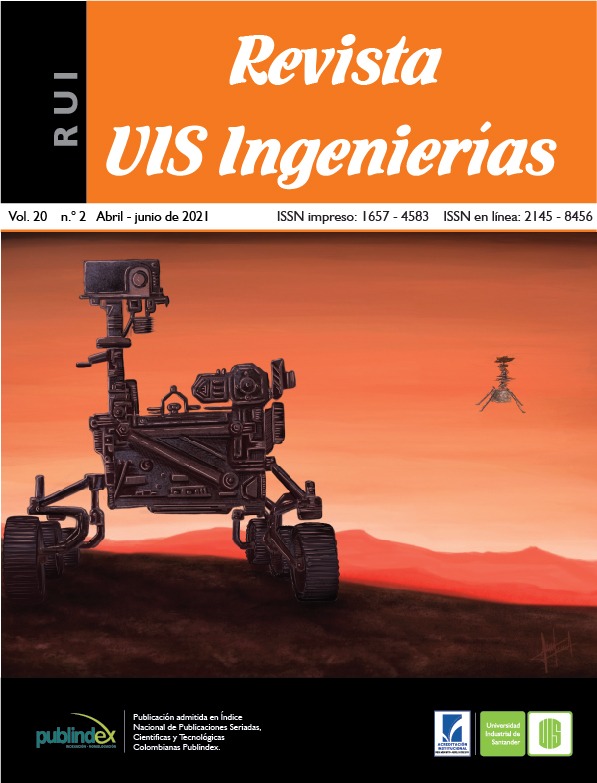Integrated wireless monitoring system of agri-environmental variables in a tomato crop for the generation of intensity maps
Published 2021-02-19
Keywords
- precision agriculture,
- agro-environmental conditions,
- graphic interface,
- LoRaWAN,
- intensity map
- instrumentation system ...More
How to Cite
Abstract
This project presents the design and construction of an integrated wireless monitoring system for the generation of intensity maps focused on precision agriculture using a four-stage methodology: general analysis, construction, software development, and validation and change management. The system has the instrumentation to measure carbon dioxide, temperature, ultraviolet radiation and humidity of the air and soil; it also implements a global positioning system that allows the creation of the maps. The data is sent through the LoRaWAN protocol to a graphic interface to visualize the behavior of each variable and generate the maps; which is built under the particular needs of a tomato crop. Finally, an adaptable system is obtained to analyze in detail the agro-environmental conditions, facilitating the farmer’s decision making.
Downloads
References
[2] J. M.-M. D. Hidalgo, “El desperdicio de alimentos, un problema global”, IndustriAmbiente: gestión medioambiental y energética, vol. 29, pp. 28-33, 2020.
[3] C. Silva, D. Baker, A. Shepherd, C. Jenane, S. Miranda da Cruz, “Tecnologías que dan forma al futuro”, en Agroindustrias para el desarrollo. Roma, Italia: La Organización de las Naciones Unidas para la Alimentación y la Agricultura, 1998, pp. 124-132.
[4] C. M. Burbano-Labrador, “Sistema de monitoreo de gases de efecto invernadero de económica implementación”, tesis de grado, Fundación Universitaria Católica Lumen Gentium, 2016.
[5] T. S. Brugler, R. A. Craig, V. C. Conzola, T. M. Eischeid, M. E. Molander, “Interactive data visualization for trend analysis”, US 8959003B2, 17-feb-2015.
[6] M. P. Wachowiak, D. F. Walters, J. M. Kovacs, R. Wachowiak Smolíková, A. L. James, “Visual analytics and remote sensing imagery to support community-based research for precision agriculture in emerging areas”, Computers and Electronics in Agriculture, vol. 143, pp. 149-164, 2017, doi:10.1016/j.compag.2017.09.035
[7] J. Gómez, S. Castaño, T. Mercado, J. García, A. Fernández, “Sistema de internet de las cosas (iot) para el monitoreo de cultivos protegidos internet”, Ingeniería e Innovación, vol. 5, no. 1, pp. 24-31, 2017, doi: 10.21897/23460466.1101
[8] T. Andrea, “Manual de cultivo del tomate al aire libre”, Instituto de Desarrollo Agropecuario - Instituto de Investigaciones Agropecuarias, Chile, Boletín INIA No. 376, 2017.
[9] S. Q. Yang, Z. Q. Yang, L. Wang, J. Li, M. Y. Zhang, K. W. Li, “Effect of high humidity and high temperature interaction on photosynthetic characteristics of greenhouse tomato crops”, Chinese Journal of Ecology, vol. 37, pp. 57-63, doi: 10.13292/j.1000-4890.201801.007
[10] O. Cárdenas, “Capítulo 6 Selección de instrumentos”, 2010. [En línea]. Disponible en: http://webdelprofesor.ula.ve/ingenieria/oscaror/CursosDictados/web%20instrumentacion%20industrial/1%20transductores%20para%20procesos%20industriales/libro%20pdf/CAP%206%20Selecci%F3n.pdf
[11] De Ruiter, “Managing Light and CO2 for Tomatoes in Protected Culture”, De Ruiter, pp. 1–2, 2019. [En línea]. Disponible en: https://www.deruiterseeds.com/en-ca/resources/cultivation-insights/managing-light-and-co2-for-tomatoes-in-protected-culture.html.
[12] H. Yamazaki, N. Suzui, Y. G. Yin, N. Kawachi, S. Ishii, H. Shimada, S. Fujimaki, “Live-imaging evaluation of the efficacy of elevated CO2 concentration in a closed cultivation system for the improvement of bioproduction in tomato fruits”, vol. 32, no. 1, pp. 31-37, 2015, doi:10.5511/plantbiotechnology.14.1210a
[13] Y. Ji, T. Li, M. Zhang, S. Sha, “Design of CO2 fertilizer optimizing control system on WSN”, vol. 46, pp. 201-207, doi: 10.6041/j.issn.1000-1298.2015.S0.033
[14] E. C. Martin, C. Munoz, Métodos para medir la humedad del suelo para la programación del riego ¿cuándo?. Tuczon, AZ, USA: College of Agriculture, University of Arizona, 2017.
[15] B. I. Ramos López et al., “Estimación del consumo de agua en plantas de tomate (solanum lycorpersicum l.) y su interacción con el microclima del invernadero”, tesis de maestría, Instituto Politécnico Nacional, 2012.
[16] H. A. Ibrahim, M. A. Abdullah, N. M. Hassan, H. S. ElBatran, “Effect of different level of solar ultra violet radiation on the vegetative growth, yield and quality of cherry tomatoes”, Bioscience Research, vol. 15, no. 3, pp. 2408-2415, 2018.
[17] A. Martinez, “Efecto de la radiación solar en la calidad de los productos horticolas”, en Congreso Internacional de Hortalizas en el Trópico, 2012, pp. 1-15.
[18] P. Radoglou-Grammatikis, P. Sarigiannidis, T. Lagkas, I. Moscholios, “A compilation of uav applications for precision agriculture”, Computer Networks, vol. 172, pp. 107-148, 2020, doi:10.1016/j.comnet.2020.107148
[19] A. R. Khanal, A. K. Mishra, D. M. Lambert, y K. K. Paudel, “Modeling post adoption decision in precision agriculture: A Bayesian approach”, Computers and Electronics in Agriculture, vol. 162, pp. 466-474, 2019, doi:10.1016/j.compag.2019.04.025
[20] M. R. Suma y P. Madhumathy, “Acquisition and Mining of Agricultural Data Using Ubiquitous Sensors with Internet of Things”, en International Conference on Computer Networks and Communication Technologies, vol. 15. Singapur: Springer, 2019, doi:10.1007/978-981-10-8681-624
[21] Meeradevi, M. A. Supreetha, M. R. Mundada, J. N. Pooja, “Design of a smart water-saving irrigation system for agriculture based on a wireless sensor network for better crop yield”, en International Conference on Communications and Cyber Physical Engineering 2018, vol. 500. Singapur: Springer, 2018, doi:10.1007/978- 981-13-0212-111
[22] D. Taskin, S. Yazar, “A Long-range context-aware platform design for rural monitoring with IoT In precision agriculture”, International Journal of Computers, Communications & Control, vol. 15, no. 2, pp. 1-11, 2020, doi:10.15837/IJCCC.2020.2.3821
[23] R. K. Singh, M. Aernouts, M. De Meyer, M. Weyn, R. Berkvens, “Leveraging LoRaWAN Technology for Precision Agriculture in Greenhouses”, Sensors, vol. 20, no. 7, p. 18-27, 2020, doi:10.3390/s20071827
[24] F. S. Muzdrikah, M. S. Nuha, F. A. Rizqi et al., “Calibration of capacitive soil moisture sensor (sku: Sen0193)”, en 2018 4th International Conference on Science and Technology (ICST). IEEE, 2018, pp. 1-6.
[25] Appconwireless, “Professional IoT solution, LoRa radio solution, LoRaWAN solution, Radio data module”, [En línea]. Disponible en: https://www.appconwireless.com/.


